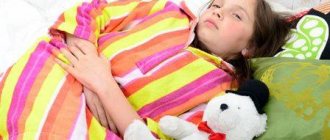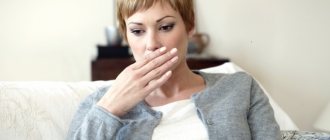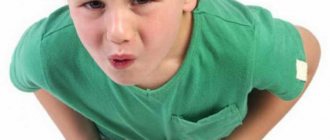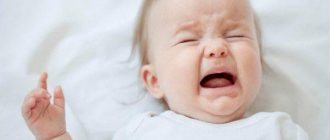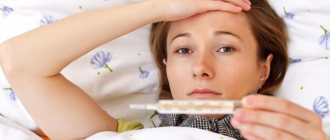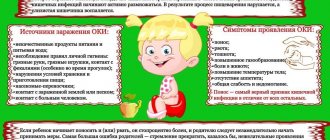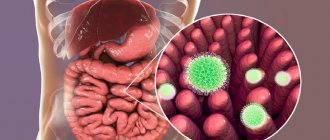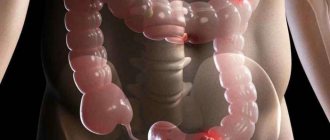Causes
Causes of green diarrhea:
- dysbacteriosis;
- intestinal infection;
- liver diseases;
- intestinal bleeding (rare).
Green-colored diarrhea appears in many newborns in the first days after birth. There is nothing dangerous in this, since meconium, the original feces, will be excreted from the child’s body over the course of several days.
In older children, green diarrhea is often a consequence of intestinal infections. In this case, the temperature may rise, weakness and abdominal pain, nausea and vomiting may occur. These are characteristic symptoms of intoxication of the body by pathogenic microflora - protozoa, viruses, bacteria and fungi. Read more about these symptoms →
Similar symptoms of green diarrhea occur in a child against the background of liver disease, only discomfort in the epigastric area and right hypochondrium may be added to them.
Dysbacteriosis is characterized by loose, greenish stools, with the presence of mucus and streaks of blood in advanced cases. In this case, diarrhea may periodically give way to constipation.
Signs of dehydration in a child
You can determine that a child has lost a large amount of moisture using the following criteria:
- pronounced lethargy and calmness;
- reduction in the number of urinations, dark color of urine;
- skin that is dry to the touch, cracked lips;
- the appearance of circles under the eyes;
- retraction of the fontanel in young children.
Any of these signs requires urgent medical attention. Otherwise, dehydration can cause even more serious complications for the child.
How dangerous is green diarrhea in a child?
The following conditions can cause complications of green diarrhea:
- dehydration - the younger the child, the more susceptible he is to this condition;
- loss of minerals and salts, which may cause seizures;
- hypovitaminosis and exhaustion;
- fissures and hemorrhoids, rectal prolapse.
Diarrhea in a child cannot be ignored. Disturbances in water, electrolyte and salt balance in the body cannot be compensated for by regular drinking; treatment must be carried out by a doctor using appropriate medications (for example, Glucose solution, Regidron, etc.).
Symptoms
It is important to find out why your child has diarrhea of this color in order to prevent complications. With this shade of stool, a wide variety of symptoms can be observed.
- If there is a high temperature, the baby may have dysentery or salmonellosis.
- Much depends on the consistency of the stool. If the discharge foams, this indicates an intestinal infection or dysbiosis. Mucus and blood clots can be a sign of dysentery. Just mucus in the stool without blood indicates salmonellosis.
- It is important to pay attention to the shade. If the color is dark green, the baby most likely has salmonellosis. If the shade is light green, there is a high probability of a common intestinal disorder.
- Smell also plays a big role in making a diagnosis. If it smells rotten and is sour, there is a high probability of developing dysbacteriosis. If there is a foul odor, the doctor may suspect an intestinal infection.
- Vomiting and regurgitation in young children indicates dysbiosis. If older children vomit, there is a high probability of dysentery. A sign of salmonellosis is continuous profuse vomiting.
Parents should pay attention to the general condition of the child. The following symptoms are quite common:
- Whims.
- Cry.
- Anxiety.
- Sleep disorders.
- Refusal of food.
- Painful sensations.
- Darkening of urine and difficulty urinating.
- Great lethargy.
- Appearance of circles under the eyes.
The worst thing with diarrhea is dehydration. This can lead to serious problems.
Signs of dehydration
- Lethargy and fatigue.
- The skin becomes dry.
- The appearance of cracks near the lips.
- Change in urine color.
- In newborns, the fontanelle sinks.
- Possible occurrence of seizures.
- Exhaustion.
- Anal fissures or rectal prolapse.
IMPORTANT: Green diarrhea is an alarming signal that requires immediate medical attention.
How to help your baby?
Green diarrhea in a child and fever are two frequent companions of pathology, which can worsen as dehydration occurs. This condition is most dangerous for children under one year of age. Due to severe fluid loss, the need to drink increases, so first aid will be to provide the child with clean drinking water.
If the baby is breastfed, before feeding you can give him 50 mg of an absorbent drug prescribed by the pediatrician. Absorbents destroy toxins and remove pathogenic microflora from the body, qualitatively softening the mucous membrane of the digestive tract and facilitating the absorption of food. For artificial babies, absorbents are added to the mixture (for example, Enterosgel).
In addition to the absorbent drug, older children can be given rice broth, which also enhances the removal of toxins from the body and restores intestinal functions.
You can try to bring down the temperature during diarrhea, which does not exceed 38.5°, on your own. To do this, you need to give the child water often and not put warm clothes on him. Antipyretics are allowed to be used only as prescribed by a doctor.
What should parents do?
Parents can alleviate the baby's condition before the doctor arrives.
- Try to give your child water as often as possible. The water must be filtered or purchased in a store. It is not recommended to give tap water.
- You should stop feeding. The only thing is that you can give kids kefir in small quantities. The best option would be dried fruit compote. But you can’t go hungry either. You should avoid food for a maximum of 6 hours.
- You should refrain from using medications. The only thing that can be used is Smecta or Entoresgel. They will help remove toxins from the body.
- It is also not recommended to use decoctions and other traditional medicine.
- In newborns, continue breastfeeding, but reduce the dose of milk consumed.
IMPORTANT: If a child, in addition to diarrhea, has a high fever and vomiting, you must call an ambulance.
What is absolutely forbidden to do?
If your baby has green diarrhea and his condition worsens, you should not self-medicate by offering him:
- painkillers (Nurofen, Ibuprofen), which can blur the picture of the disease, the symptom of which is diarrhea;
- tetracycline antibiotics, which are often used for diarrhea in adults, but are highly toxic in children;
- medications intended for adolescents and adults (Imodium, Loperamide);
- force the child to eat;
- limit fluid intake for fear of new attacks of diarrhea or vomiting;
- offer raw vegetables and fruits, as well as heavy foods that irritate the digestive tract;
- put ice or a heating pad on your stomach.
Self-medication for childhood diarrhea may make the situation worse. It is necessary to seek help from a doctor.
In what cases is it necessary to urgently call a doctor?
Green diarrhea in a child is already a suspicious sign that you need to pay attention to, but not cause panic. Before calling a doctor, it is important to assess the baby’s well-being. Fever and abdominal pain are an urgent reason to call an ambulance, especially if we are talking about a child under 3 years old.
The doctor will not only determine the cause of the pathology, but will also prescribe a comprehensive course of treatment. As a rule, it consists of drugs that normalize the water-salt balance in the body (Regidron), sorbents (Smecta) and agents that restore intestinal microflora (Linex, Bifidumbacterin, etc.).
Medicines will also be prescribed to eliminate the root cause of green diarrhea in the child. For example, if the pathology arose against the background of an intestinal infection, it will be antibiotics (Sumamed, Levomycetin, etc.). The specialist will also determine a diet for the child, which will have to be followed for several days.
You can limit yourself to calling a local pediatrician at home if the child’s health is normal, but the green diarrhea does not stop - most likely, it is a symptom of dysbiosis. After the doctor confirms the diagnosis, the baby will be prescribed medications for outpatient treatment aimed at strengthening the body’s defenses and combating dysbiosis (Maxilak Baby, Hilak Forte, etc.).
Doctor's treatment
First of all, the doctor prescribes a therapeutic diet for a certain period of time. The following drugs are prescribed:
1. If dysbiosis is detected, the doctor may prescribe one of the drugs:
- Linux;
- Enterol;
- Bifidiumbacterin;
- Bifilin.
2. For intestinal infection, the following prescription is possible:
- Ercefuril;
- Furazolidone;
- Rifampicin;
- Kanamycin;
- Meronem et al.
3. Treatment includes bacteriophages, eneterosorbents, lactoglobulins, immunoglobulins.
4. Enzymes are prescribed:
- Pancreatin;
- Festal;
- Mezim;
- Pankurmen;
- Creon.
5. The doctor may prescribe antiallergic drugs.
6. Antidiarrheals:
- Imodium;
- Diarol.
7. To relieve pain, the following are prescribed:
- Papaverine;
- Drotaverine.
Complications
The list of complications is:
- dehydration of the body;
- convulsive syndrome at high temperature;
- dysbacteriosis, which, in turn, can lead to bronchial asthma, dermatitis, gastroduodenitis and other chronic diseases;
- neurotoxicosis, cerebral edema, toxic shock, sepsis, coma as consequences of an untreated intestinal infection.
Prevention
Prevention of diarrhea with a green tint in a child consists of the following measures:
- A woman who is breastfeeding should strictly follow the diet and, if possible, not take medications, especially antibiotics.
- A formula-fed infant with frequent recurrences of diarrhea should be examined by a pediatrician or pediatric gastroenterologist to diagnose the pathology and select an appropriate formula.
- The first complementary foods should be introduced gradually and carefully. The green color of diarrhea may be an individual reaction of the baby to any food product. In this case, you should refuse the food that provokes the pathology and wait until the digestive tract gets stronger.
- It is important to feed children over 3 years of age fully and correctly, avoiding excess amounts of high-carbohydrate foods and greens in the daily diet.
- Do not put a baby's pacifier or spoon in your mouth. Causative agents of intestinal infection may be present in the saliva of an adult.
If your baby has green diarrhea, you first need to find out the cause of the pathology, and then begin to act. It is best to consult a doctor immediately, which will reduce the likelihood of complications. To prevent green diarrhea from recurring in a child, it is important to devote time to prevention.
Author: Olga Rogozhkina, doctor, especially for Mama66.ru
Treatment methods for green diarrhea in children of different ages
After birth, the baby's stool is sticky and dark olive in color. This original, cleansing stool, called meconium, is normal and does not require treatment.
Green diarrhea is not uncommon in a baby of the first year of life; it appears due to an incorrect latch on the breast, in which the baby receives only watery foremilk, from a lack of enzymes in the small stomach, after the introduction of vegetable complementary foods.
If a child of the first year of life has all the signs of an intestinal infection - fever, frequent diarrhea of a light or dark shade of green, vomiting, which removes fluid from the baby’s body, you cannot hesitate - you must urgently call an ambulance.
In infants under 3 months of age, in order to avoid seizures, a temperature above 38°C-38.2°C is reduced orally with an antipyretic drug based on paracetamol.
Before the ambulance arrives, you should give a teaspoon of solutions every half hour that prevent moisture loss (Regidron, Enterodes). If the baby is breastfed, it is important to put it to the breast as often (but not for long) as possible. It is better to limit the diet of bottle-fed infants until the doctors arrive, in order to avoid regurgitation, and give only fractional portions of the mixture.
Infants older than 1-2 months are allowed to drink herbal infusions of chamomile and fennel - they have a beneficial effect on the mucous membrane of the small stomach and intestines. Your baby can drink 250 ml of herbal tea in small portions per day.
Enterosorbents (black coal, Enterosgel, Smecta, Neosmectin) absorb and remove toxins from the body. They will help treat diarrhea in infants and older children. When using them, it is important to consider weight. For bottle-fed children, sorbent can be added to the mixture.
Green, loose stool in a small child 2-3 years old should cause caution and a careful analysis of the food consumed. If you have green diarrhea without fever, acute vomiting or other manifestations of an intestinal infection, you can try to get rid of it at home by giving your baby a starch solution (dilute half a tablespoon of powder in half a glass of water) or by cooking jelly with starch.
If a small child has green diarrhea accompanied by fever, lethargy, and vomiting, immediate medical attention is necessary. The exact diagnosis of what caused the green stool will be determined after examination.
Children 3-4 years old and older are given small drinks, possibly sweetened. To prepare a rehydration solution at home, take half a teaspoon of salt, soda, sugar per glass of boiled water. It is better to exclude fruit juices, compotes, fruit drinks, carbonated drinks from the diet.
Rice water will help reduce the intensity of diarrhea. Boil half a glass of rice for at least 40 minutes in three glasses of water. Give a tablespoon of decoction every hour. For older children (5, 6 years old), in addition to tea from chamomile, mint, fennel, you can give healing decoctions from oak bark and sage. Abdominal cramps and pain are relieved with antispasmodic drugs (Papaverine, No-shpa), dosing them according to the instructions.
However, treatment of diarrhea can have the opposite effect – constipation. Then the baby’s stool is “relaxed” with 0.5-1 teaspoon of natural vegetable oil (sea buckthorn, olive).
You should not self-medicate by giving your child antibiotics. This may complicate his condition. It is not recommended to lower the temperature below 38.5 - the body fights the infection on its own, there is no need to interfere with this.
The set of therapeutic measures prescribed to eliminate green diarrhea depends on the age of the child. Medical treatment includes a special diet, medications to maintain beneficial microflora, and antidiarrheal and antibacterial tablets. The main task for each age (the younger, the faster you need to act) is maintaining water and electrolyte balance in the body, categorically preventing dehydration.
What information is missing from the article?
- What frequency of bowel movements is considered normal and what is considered a disease?
- More recipes to stop diarrhea at home
- Description of cases for contacting a doctor
- Review of drugs
- Is the disease serious?
